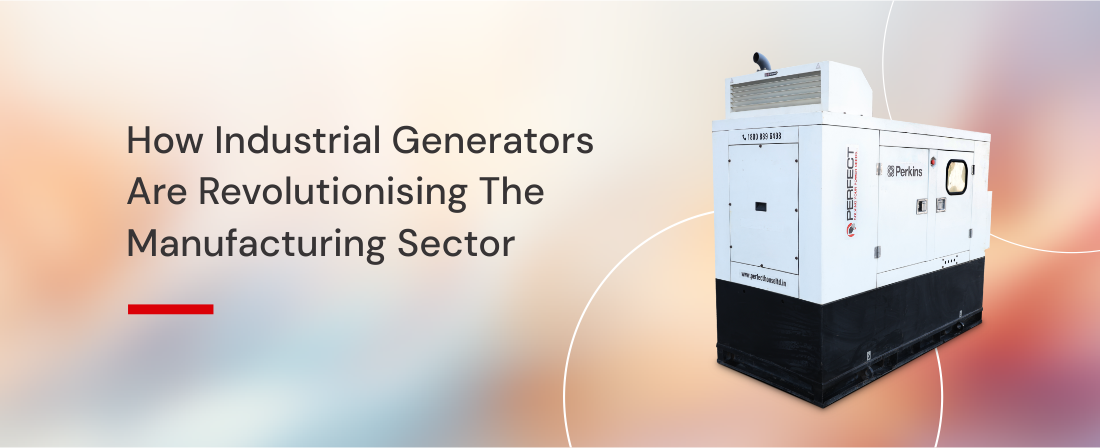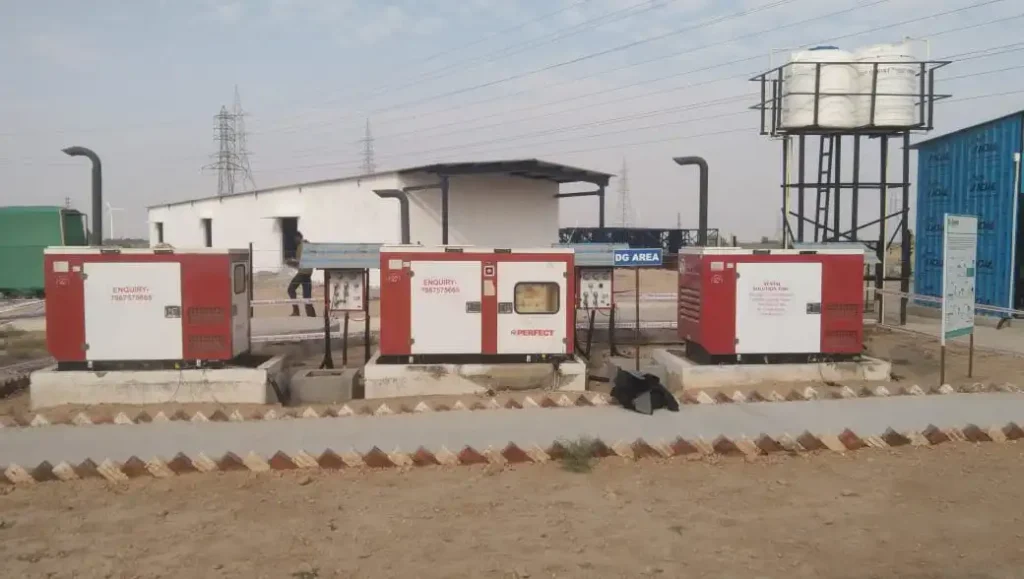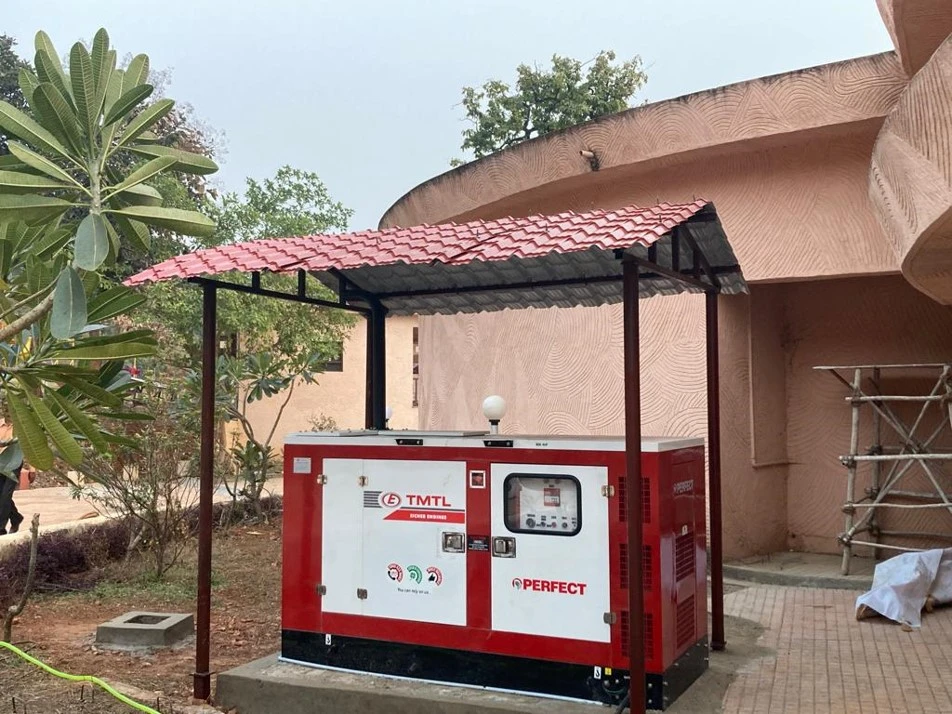
How Industrial Generators Are Revolutionizing The Manufacturing Sector
The manufacturing landscape, once synonymous with smokestacks and heavy industry, is undergoing a significant transformation. At the heart of this evolution lies a powerful force: the industrial generator.
More than simply a backup solution, these versatile machines are revolutionising production processes, enhancing flexibility, and driving sustainability initiatives.
Let’s look at the transformative impact of industrial generators on manufacturing, explore their contributions to enhanced productivity, improved scalability, and environmental responsibility.
From Backups to Bosses: The Rise of Industrial Generators

Grid Instability
Indians are no strangers to power outages and grid fluctuations, particularly in remote areas. These disruptions can cripple production, leading to lost revenue and frustrated employees.
Industrial generators provide a dependable safety net, ensuring uninterrupted operations even during grid instability. Imagine a bustling manufacturing plant in your region, where a sudden power cut could halt operations and spoil expensive materials. A strategically placed industrial generator can prevent such scenarios, creating a smooth flow of production and protecting your valuable resources.
- Production Delays: Inconsistent power leads to frequent manufacturing process disruptions, slowing production.
- Remote Operations: The vastness and resource wealth of India necessitates numerous off-grid facilities, from mines to farms sprawling across remote landscapes. These locations often lack access to the national grid, making industrial generators their lifeline. Consider a gold mine in Western India, miles from the nearest power line. A reliable generator is ensuring the smooth operation of vital mining equipment and provides essential power for the lives of those residing on-site.
- Financial Strain: Unreliable power supply forces industries to invest in backup systems, increasing operational costs.
- Loss of Data: Power interruptions may cause data loss, affecting critical information and operational efficiency.
- Employee Productivity: Frequent power cuts disrupt workflow, reducing employee productivity and morale.
- Supply Chain Disruptions: Industries heavily reliant on electricity face challenges maintaining a smooth supply chain.
- Competitive Disadvantage: Companies need a stable power supply to compete effectively.
- Technological Constraints: Inadequate power hinders the adoption of advanced technologies, limiting innovation.
- Reliability Concerns: Unstable power sources create uncertainty, making it difficult for industries to plan and meet production targets.
Remote Operations:

Cost-Effectiveness:
While initially seen as an expensive proposition, the economics of industrial generators have shifted significantly. Fluctuating grid energy prices and government incentives for renewable generators are making them a more attractive option.
Additionally, advancements in technology have led to more fuel-efficient and cost-effective models. Picture a manufacturing plant in South India, facing soaring electricity bills. By investing in a natural gas-powered generator, you can achieve greater control over your energy costs and potentially save a significant amount over time.
Evolving Applications:
While initially seen as an expensive proposition, the economics of industrial generators have shifted significantly. Fluctuating grid energy prices and government incentives for renewable generators are making them a more attractive option.
Additionally, advancements in technology have led to more fuel-efficient and cost-effective models. Picture a manufacturing plant in South India, facing soaring electricity bills. By investing in a natural gas-powered generator, you can achieve greater control over your energy costs and potentially save a significant amount over time.
Cost-Effectiveness:
Industrial generators are no longer confined to standby power. They are increasingly used for peak shaving, where they supplement grid power during high-demand periods, reducing reliance on expensive peak-hour tariffs.
Additionally, some manufacturers are exploring microgrid solutions, where generators work in conjunction with renewable energy sources like solar panels to create self-sufficient and sustainable power systems. This opens up exciting possibilities for remote operations and environmentally conscious businesses. To know more about your generator options, click here.
Revolutionising the Manufacturing Landscape: More Than Just Backup
Enhanced Productivity & Efficiency:
Uninterrupted Operations: Forget costly downtime due to power cuts! Generators ensure continuous production, minimising lost time and maximising output.Imagine a meat processing plant where even a brief power outage can spoil thousands of dollars worth of product. A generator ensures uninterrupted operation, safeguarding your production and profitability.
Peak Performance: Fluctuations in grid power can negatively impact equipment performance. Generators provide stable and consistent power, optimising equipment performance and reducing energy waste. Picture a precision engineering workshop where delicate machinery requires consistent power. A generator ensures smooth operation, minimising errors and maximising product quality.
Customization: Modern generators offer precise power control, allowing manufacturers to tailor their energy usage to specific processes. This optimisation reduces energy consumption and lowers overall production costs. Think of a textile factory where different machines have varying power demands. Generators allow for customised power allocation, minimising energy waste and maximising cost efficiency.
Improved Flexibility & Scalability:
Off-grid Freedom: Generators empower businesses to set up operations anywhere, regardless of grid access, opening doors to new opportunities. Imagine a food processing plant seeking to capitalise on fresh, locally sourced ingredients in a remote location. A generator provides the power needed to establish their operation, unlocking new economic possibilities.
Modular Scalability: Production needs can fluctuate rapidly. Generators offer flexible solutions, easily scaling up or down as demand changes. Picture a seasonal toy manufacturer experiencing peak production during the holidays. Generators allow them to seamlessly increase power during busy periods and scale down afterwards, avoiding unnecessary energy costs.
Fuel Diversity: From diesel and gas to renewable sources like biogas and solar, generators offer fuel options to suit specific needs and environmental goals. Consider a biofuel company seeking to reduce their carbon footprint. Biogas-powered generators provide a sustainable and reliable power source, aligning with their environmental values and contributing to a greener future.
Sustainability & Environmental Impact:
Reduced Reliance on the Grid: This translates to less strain on the national grid and lower carbon emissions. Imagine a large manufacturing plant switching to a solar-powered generator. Their reliance on the grid reduces, contributing to a more sustainable electricity mix and reducing overall greenhouse gas emissions.
Renewable Options: Biogas and solar-powered generators offer clean and sustainable power generation, minimising environmental impact. Imagine a dairy farm utilising a biogas generator powered by manure waste. They convert waste into energy, reducing their environmental footprint and contributing to a circular economy.
Energy Efficiency: Modern generators are designed for optimal efficiency, reducing fuel consumption and emissions. Consider a food processing plant investing in a high-efficiency diesel generator. They use less fuel to produce the same amount of power, minimising their environmental impact and operating costs.

The Future is Bright: Where Industrial Generators are Heading
Smart Integration:
Imagine a world where generators seamlessly integrate with smart grids and renewable energy sources. This isn’t science fiction; it’s the future of power generation.
Advanced communication protocols enable generators to communicate with other grid components, optimise energy usage in real-time, and automatically adjust settings based on demand and weather conditions. Picture a manufacturing plant with a solar-powered generator that automatically switches to grid power during peak demand and seamlessly integrates with energy storage solutions for optimal efficiency.
Data-Driven Optimization:
In the future, generators will not merely operate autonomously; instead, they will engage in communication with other grid components.
Advanced sensors and analytics will collect real-time data on performance, fuel consumption, and environmental factors. This data will be used to optimise generator performance, predict maintenance needs, and identify potential issues before they occur. Imagine a remote mine using a data-driven platform to monitor its generator’s performance in real-time, allowing for proactive maintenance and preventing costly downtime.
Remote Management:
Final Thoughts: Powering the Future of Indian Manufacturing
Industrial generators are no longer just backup options; they’re becoming essential tools for Indian manufacturers seeking to boost productivity, improve flexibility, and embrace sustainability.
As technology evolves and the demand for clean energy grows, these mighty machines are poised to play an even more critical role in powering the future of Indian manufacturing.
So, the next time you see a generator humming away, remember, that it’s not just keeping the lights on, it’s powering progress and innovation in Indian industries!


Post a comment